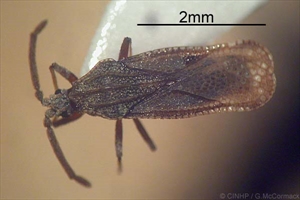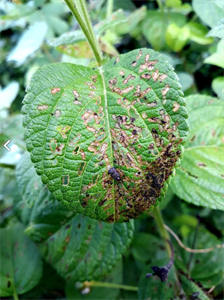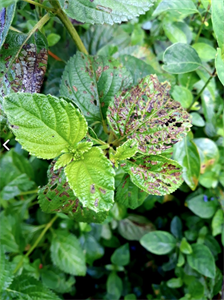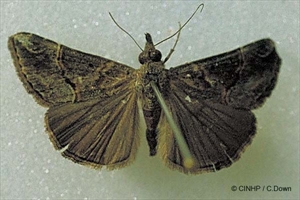Lantana
Pacific Pests, Pathogens and Weeds - Online edition
Pacific Pests, Pathogens & Weeds
Lantana (434)
Lantana camara. There are many sub-species and hundreds of varieties and hybrids of different colours, hairiness, thorniness, height, etc. that have been bred as ornamentals. There are also several species. Two groups are recognised worldwide: one with (few) or no spines (South and Central America, and the Caribbean), and the other with spines. The common variety in the Pacific islands is the one that is prickly. It is a member of the Verbenaceae.
Africa, Asia, North, South and Central America, the Caribbean, Europe, Oceania. It is recorded from Australia, Cook Islands, Federated States of Micronesia. Fiji, French Polynesia, Guam, Kiribati, Marshall Islands, Nauru, New Caledonia, New Zealand, Niue, Northern Mariana Islands, Palau, Papua New Guinea, Samoa, Solomon Islands, Tonga, Tuvalu, Vanuatu, and Wallis & Futuna.
The native range of the species is tropical and subtropical America.
Lantana is an aggressive invasive weed that grows in dense impenetrable clumps or as a climbing vine over wide areas. It grows in a range of environments, including high-rainfall tropical, sub-tropical and temperate climates. It does not grow well in dry or salty soils. Invasiveness is due to rapid reproduction through seeds, which are spread by birds and other animals, suckers, and stem fragments. Introduction around the world is because of its use as an ornamental.
Stems are square in cross-section, with or without spines; leaves are in opposing pairs, each about 6 cm long, bright green, with serrated margins, and covered in fine hairs (Photo 1). Flowers in a cluster about 3 cm across, varying from white, cream, pink, orange and red. The fruit is a green berry-like and purplish-black when mature (Photo 2). Large numbers of seeds are produced, and these remain viable for several years.
Spread occurs over short distances by layering (rooting) of stems. Over long distances, spread occurs via the horticulture trade, and local dispersal of seeds by birds and other animals. Lantana has spread from gardens where it is grown as an ornamental to pastures, woodlands, rainforests, commonly into disturbed lands and along river margins.
The Government of Queensland states that more than 5 million ha are covered with lantana in far north Queensland and NSW, impacting pastures, native vegetation and animals. In plantations of coconuts, coffee, oil palms and bananas it reduces productivity, and interferes with harvesting. Other impacts relate to harbouring rats, and in Africa a shelter for tsetse flies. It is also said that the stems are combustible creating hotter bushfires. Some varieties are highly poisonous, causing deaths of livestock (cattle, sheep and goats) affecting skin, eyes, and liver. In Fiji, it is a problem in coconut plantations, pastures and neglected arable land. Death can occur within 1-4 weeks depending on the age of the animal and the amount of lantana eaten. Green and ripe fruits are poisonous to human beings, especially to children who have eaten the berries.
Main use is as an ornamental. In East Africa as a live fence (here it is not weedy). Traditional medicinal uses are reported, and a food for bees. CABI records leaf extracts have insecticidal properties, and that leaves can control damage from potato tuber moth (see Fact Sheet no. 298).
BIOSECURITY
Lantana is highly invasive being spread via the international horticultural trade and locally by birds. It is on the list of the 100 of the World's Worst Invasive Species compiled by the Global Invasive Species Database, maintained by the IUCN Invasive Species Specialist Group.
For those countries not yet invaded by lantana, it is imperative that legislation is in place to control its introduction. For those countries where it is already present, legislation should prevent its further introduction and distribution. For instance, permits should be required for plants to be sold, given away or released into the environment.
NATURAL ENEMIES
Waterhouse & Norris1 reviewed attempts at biological control beginning in Hawaii in 1902, and 1914 in Australia. Several hundred insects that chew, bore, mine or suck leaves and stems have been investigated, but they concluded that lantana is still a problem in many countries; this is due to differences between the many varieties, and the many habitats where lantana excels. These authors call for a study of the diversity of lantana in Pacific island countries in order to match it with potential biocontrol agents.
The four main natural enemies are the bug, Teleonemia scrupulosa (adults and nymphs suck the leaves causing dieback) (Photo 3), the chrysomelids, Uroplata girardi (lavae mine leaves, adults feed on upper surfaces (Photos 4-6), and Octotoma scabripennis (larvae cause blotch mines, adults feed on upper surfaces) (Photo 7), and the seed-mining fly, Ophiomyia lantanae. Other useful candidates are the leaf-mining fly, Calycomyza lantanae, and the moths, Hypena strigata (Photo 8), Neogalea esula, and Salbia haemorrhoidalis.
Many of these have been released in Pacific island countries (Cook Islands, Federated States of Micronesia, Fiji, Guam, Northern Mariana Islands, New Caledonia, Papua New Guinea, Samoa, Solomon Islands, Tonga, and Vanuatu). In addition to releases of insects, fungal rusts (Prospodium species) have been released in Australia and New Zealand.
CULTURAL CONTROL
- Digging out lantana is effective, even if laborious, and there may be regrowth from roots left in the ground that need herbicide treatment.
- Slashing can also be effective if that too is followed by herbicide treatment to deal with regrowth.
- On large areas, raking, ploughing and even bulldozing are used but, again, seeds will germinate, and regrowth will occur making follow-up herbicide treatments a necessity.
- Fire is often used before mechanical or herbicide control. Be careful to manage the risks of fire to people, property and the environment.
- Revegetation of treated areas is important to smother lantana regrowth. Improved pastures, ground legumes, planting trees or encouraging seedlings of previous species are methods used depending on the site and its history.
CHEMICAL CONTROL
The following herbicides are registered in Australia: 2,4,-D (amine); 2,4-D + picloram; dichlorprop-p; fluroxypyr; fluroxypyr + aminopyralid; glyphosate (and Fiji); glyphosate + metsulfuron-methyl; triclopyr; triclopyr + picloram; picloram + triclopyr + aminopyralid; picloram + aminopyralid; metsulfuron-methyl (and Fiji). Treat plants about 6 weeks after rains (at least 35 mm).
--------------------
Note, EU approval to use glyphosate ends in December 2022; its use after that date is under discussion.
____________________
When using a pesticide, always wear protective clothing and follow the instructions on the product label, such as dosage, timing of application, and pre-harvest interval. Recommendations will vary with the crop and system of cultivation. Expert advice on the most appropriate herbicides to use should always be sought from local agricultural authorities.
AUTHORS Grahame Jackson & Aradhana Deesh
Information from 1Waterhouse DF, Norris KR (1987) Lantana camara Linnaeus Biological Control Pacific Prospects. Inkata Press. Melbourne; and Lantana (Lantana camara). Department of Agriculture and Fisheries. Biosecurity. Queensland; and CABI (2019) Lantana camara (lantana). Crop Protection Compendium. (https://www.cabi.org/cpc/datasheet/29771); and from CHAH (2011) Lantana camara L. WeedsAustralia - Profiles. Department of Sustainability, Environment, Water, Population and Communities. (https://profiles.ala.org.au/opus/weeds-australia/profile/Lantana%20camara). Photos 1,2&4 Gerald McCormak, Cook Islands Biodiversity & Natural Heritage. (http://cookislands.bishopmuseum.org). Photo 5 Coleoptera Chrysomedlidae t034 Octotoma scabripennis. Edithvale-Australia Insects. (https://www.flickr.com/photos/69610519@N08/6462736025/).
Produced with support from the Australian Centre for International Agricultural Research under project HORT/2016/185: Responding to emerging pest and disease threats to horticulture in the Pacific islands, implemented by the University of Queensland and the Secretariat of the Pacific Community.











